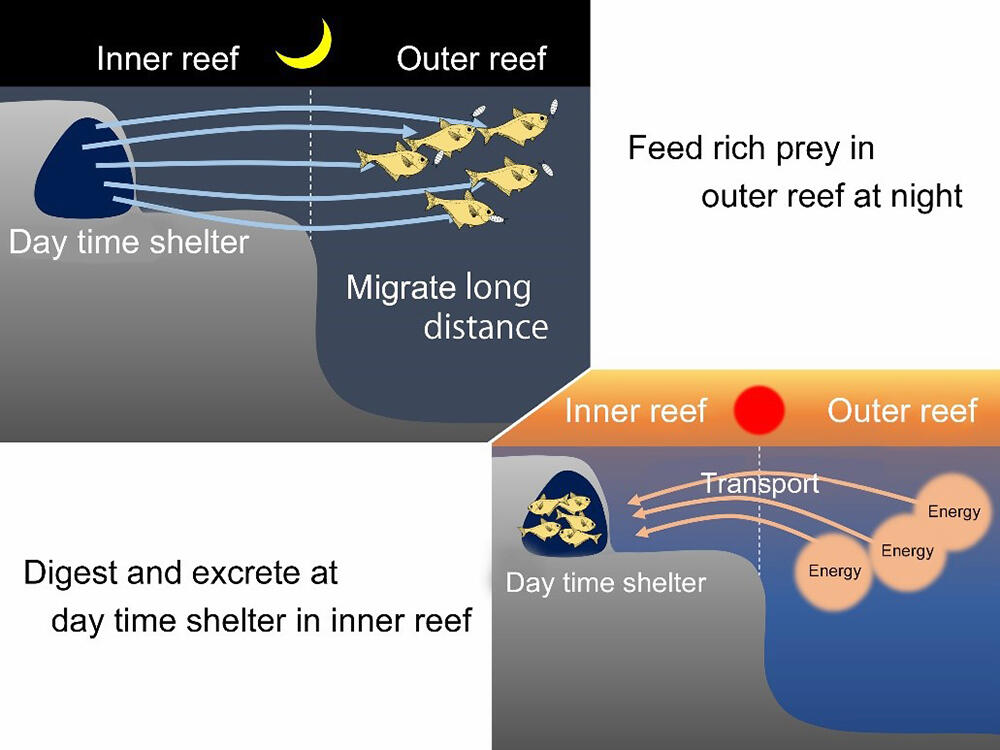The research group comprising Specially Appointed Assistant Professor Keita Koeda of the University of Tokyo University Museum, Manager (at the time) Hideyuki Touma of the Okinawa Churaumi Aquarium, and Professor Katsunori Tachihara of University of the Ryukyus Faculty of Science announced that they have clarified the behavioral ecology of the nocturnal fish, Pempheris schwenkii, by observing their swimming behavior and tracking them using a chemical luminescent tag. It was found that Pempheris schwenkii emerged from the coral reefs shortly after sunset and traveled long distances beyond the reef. This research result is expected contribute to a greater understanding of coral reef ecosystems. The groups' findings were published in the November 16th issue of the international scientific journal PeerJ.

(Provided by Keita Koeda)
Pempheris schwenkii is a nocturnal fish in the order Perciformes, family Pempheridae, and the adults are 12-15 cm in length. During the daytime, large groups of individuals gather in the darkness of the underwater caves found in coral reef areas. It was known that they disappeared from their daytime habitat at night, but their behaviour during that time was unknown.
There are very few examples of ecological research on nocturnal fish. This is because nocturnal fish are sensitive to light and so disperse when in its presence. As a result, it is not possible to conduct observations in the dark with standard practices.
In this study the research group attached a tag that emits a small fluorescent (chemical) light to captured Pempheris schwenkii, and after the fish were released the researchers surveyed them observing their swimming behavior, relying only on the fluorescent light. A biologging device was not used as it interfered with the swimming patterns of the small fish. As detailed observations cannot be made in the dark in the field , the research group also observed breeding individuals within an aquarium at night at the Okinawa Churaumi Aquarium.
Specifically, from May to June 2012 an individual was collected from an underwater cave in Onna Village, Okinawa Prefecture, where Pempheris schwenkii resides, and was then released after a small glowing tag was attached to it. Observation began one hour before sunset, and the school of fish started to migrate all at once after sunset. Observers swam at distances of several meters from the fish and tracked individuals with glowing tags, recording their movements, the depths they were at, and paths travelled for over an hour.
The results showed that the longest distance traveled by an individual was 700 meters per hour and the shortest distance traveled by an individual was 400 meters. It was confirmed that this movement was not limited to within the coral reef, which is shallow and where escape from predators is easy, but that the fish also moved and migrated to 150 meters offshore from the coral reef. If the sea is calm, the fish frequently move to deeper waters, and examination of their stomach contents showed that the fish also move to the surface layer. Although the fish are sensitive to light, it was confirmed that even with a glowing tag, untagged individuals do not seem to avoid tagged individuals in the daytime. The individual did not appear to escape from the observer during the offshore pursuit. It should be noted that the observer also used chemical light when making recordings. However, no behavior other than movement can be observed in the sea at night.

(Provided by Keita Koeda)
With these findings in mind, the researchers also conducted nighttime investigations of the population that was bred at the Okinawa Churaumi Aquarium. In this survey, it was observed that after the lights were turned off, all the fish emerged from their daytime habitat and swam to the vicinity of the water outlet of the aquarium. It was confirmed that eggs were laid only once at the destination.
From these observation results, it was speculated that Pempheris schwenkii lay eggs and feed after leaving the coral reef at night. There is a comparatively higher risk of them being targeted by predators outside the coral reef than inside it. However, at night, benthic zooplankton hidden in the seabed during the day can be found in the water, enabling the utilization of abundant nutrients that diurnal fish cannot use.

(Provided by Keita Koeda)
Previous studies have shown Pempheris schwenkii have a larger population and grow faster than other diurnal fish in coral reefs and that they have a long breeding season of six months. This biology may be the result of abundant nutrients being available to them but not to other fish species. By maintaining more individuals in this ecosystem, the fish become an important food resource for higher-level predators. At the same time, it has become clear that the fish may play an important role in the energy circulation in the coral reefs via the digestion and excretion of food obtained from the outside of the rich coral reef to the interior ecosystem. Specially Appointed Assistant Professor Koeda said, "Pempheris schwenkii is thought to grow rapidly and lay eggs frequently by taking risks and obtaining a large amount of food. In the future, we would like to verify whether similar ecology can be seen in other nocturnal fish such as those from the Holocentridae family."
This article has been translated by JST with permission from The Science News Ltd.(https://sci-news.co.jp/). Unauthorized reproduction of the article and photographs is prohibited.




